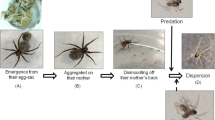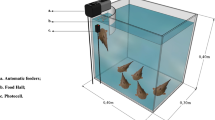Abstract
Groups of laboratory-reared, juvenile lobsters (Homarus gammarus, 40–50 g wet weight) were given different types of food (shrimp, mixed invertebrates and pellets, bivalves, starved) for a period of 22 wk. Haemocyanin concentration was measured weekly, moult stage and moultings noted. Haemocyanin concentration decreased rapidly in the starved group (from 0.8–0.6 to 0.2 mM). The group fed with bivalves showed a small decline with time, to 0.5–0.3 mM at the end of the period, indicating a deficient diet. The haemocyanin in the other groups did not change significantly during the experiment. Moultings decreased in frequency and the intermoult period was prolonged when the quality of food was decreased, and in the starved group moulting ceased completely after 1.5 months. Haemocyanin concentration was lowest immediately after moult and increased gradually through stages C and D. Lobsters that were starved or maintained on the bivalve diet did not reach the same premoult haemocyanin levels as those fed with shrimps and mixed food.
Similar content being viewed by others
Literature cited
Adelung, D.: Untersuchungen zur Häutungsphysiologie der decapoden Krebse am Beispiel der Strandkrabbe Carcinus maenas. Helgoländer wiss. Meeresunters. 22, 66–119 (1971)
Antonini, E. and M. Brunori: Transport of oxygen; respiratory proteins. In: Molecular oxygen in biology: topics in molecular oxygen research, pp 219–274. Ed. by O. Hayaishi. Amsterdam: North-Holland 1974
Boone, W. R. and E. Schoffeniels: Hemocyanin synthesis during hypo-osmotic stress in the shore crab Carcinus maenas (L.). Comp. Biochem. Physiol. 63 B, 207–214 (1979)
Bottoms, A.: Some aspects of the respiratory physiology of Cancer pagurus L. (Crustacea: Decapoda) in Scottish west coast waters. Thesis, University of Stirling, 174 pp. 1977
Butler, P. J., E. W. Taylor and B. R. McMahon: Respiratory and circulatory changes in the lobster (Homarus vulgaris) during long term exposure to moderate hypoxia. J. exp. Biol. 73, 131–146 (1978)
Castell, J. D. and S. D. Budson: Lobster nutrition: the effect on Homarus americanus of dietary protein levels. J. Fish. Res. Bd Can. 31, 1363–1370 (1974)
Djangmah, J. S.: The effects of feeding and starvation on copper in the blood and hepatopancreas, and on blood proteins of Crangon vulgaris (Fabricius). Comp. Biochem. Physiol. 32, 709–731 (1970)
Glavind, J.: Studies on the coagulation of crustacean blood, 138 pp. Copenhagen: Nyt Nordisk Forlag, Arnold Busk 1948
Glynn, J. P.: Studies on the ionic, protein and phosphate changes associated with the moult cycle of Homarus vulgaris. Comp. Biochem. Physiol. 26, 937–946 (1968)
Hagerman, L. and R. E. Weber: Respiratory rate, haemolymph oxygen tension and haemocyanin level in the shrimp Palaemon adspersus Rathke. J. exp. mar. Biol. Ecol. 54, 13–20 (1981)
Horn, E. C. and M. S. Kerr: Hemolymph protein and copper concentrations of adult blue crabs (Callinectes sapidus Rathbun). Biol. Bull. mar. biol. Lab., Woods Hole 125, 497–507 (1963)
Klein Breteler, W. C. M.: Laboratory experiments on the influence of environmental factors on the frequency of moulting and the increase in size at moulting of juvenile shore crabs, Carcinus maenas. Neth. J. Sea Res. 9, 100–120 (1975)
Lockwood, A. P. M.: Aspects of the physiology of Crustacea, 328 pp. Edinburgh & London: Oliver & Boyd 1968
Mangum, C. P. and A. L. Weiland: The function of hemocyanin in respiration of the blue crab Callinectes sapidus. J. exp. Zool. 193, 257–264 (1975)
Meixner, R.: Wachstum, Häutung und Fortpflanzung von Crangon crangon (L.) bei Einzelaufzucht. Ber. dtsch wiss. Komm. Meeresforsch. 20, 93–111 (1969)
Miller, K. I., A. W. Pritchard and P. S. Rutledge: Respiratory regulation and the role of the blood in the burrowing shrimp Callianassa californiensis (Decapoda: Thalasinidae). Mar. Biol. 36, 233–242 (1976)
Nickerson, K. W. and K. E. van Holde: A comparison of molluscan and arthropod hemocyanin. I. Circular dichroism and absorption spectra. Comp. Biochem. Physiol. 39B, 855–872 (1971)
Passano, L. M.: Molting and its control. In: The physiology of Crustacea, Vol. 1, pp 473–536. Ed. by T. H. Waterman. New York: Academic Press 1960
Senkbeil, E. G. and J. C. Wriston, Jr.: Hemocyanin synthesis in the American lobster, Homarus americanus. Comp. Biochem. Physiol. 68B, 163–171 (1981)
Spoek, G. L.: The relationship between blood haemocyanin level, oxygen uptake, and the heart-beat and scaphognathite-beat frequencies in the lobster Homarus gammarus. Neth. J. Sea Res. 8, 1–26 (1974)
Stewart, J. E. and M. F. Li: A study of lobster (Homarus americanus) ecology using serum protein concentrations as an index. Can. J. Zool. 47, 21–24 (1969)
Stewart, J. E., J. W. Cornick, D. M. Foley, M. F. Li and C. M. Bishop: Muscle weight relationship to serum protein, hemocytes, and hepatopancreas in the lobster (Homarus americanus). J. Fish. Res. Bd Can. 24, 2339–2354 (1967)
Uglow, R. F.: Hemolymph protein concentrations in portunid crabs. I. Studies on adult Carcinus maenas Comp. Biochem. Physiol. 30, 1083–1090 (1969a)
Uglow, R. F.: Hemolymph protein concentrations in portunid crabs. II. The effect of imposed fasting on Carcinus maenas. Comp. Biochem. Physiol. 31, 959–967 (1969b)
Wieser, W.: Electrophoretic studies on blood proteins in an ecological series of isopods and amphipods. J. mar. biol. Ass. U.K. 45, 507–523 (1965)
Zuckerkandl, E.: Hémocyanine et cuivre chez un crustacé décapode, dans leur rapports avec le cycle d'intermue. Annls. Inst. océanogr., Monaco 38, 1 122 (1960)
Author information
Authors and Affiliations
Additional information
Communicated by T. Fenchel, Aarhus
Rights and permissions
About this article
Cite this article
Hagerman, L. Haemocyanin concentration of juvenile lobsters (Homarus gammarus) in relation to moulting cycle and feeding conditions. Mar. Biol. 77, 11–17 (1983). https://doi.org/10.1007/BF00393205
Accepted:
Issue Date:
DOI: https://doi.org/10.1007/BF00393205




